Analysis of Evidence-Based Practice in a Mental Health Setting
VerifiedAdded on 2023/01/05
|16
|3547
|41
Essay
AI Summary
This essay provides a comprehensive analysis of evidence-based practice (EBP) in mental health nursing. It defines EBP, outlining its principles and processes, and emphasizes its role in improving clinical practice and patient outcomes. The essay focuses on a mental health ward setting, exploring barriers and facilitators to EBP implementation, such as staffing, funding, and cultural competence. It examines specific applications of EBP, including interventions for accidental falls among older adults with dementia, and the use of mindfulness-based therapy for depression and anxiety. The paper also includes a PICO table to formulate a research question regarding the effectiveness of physical exercise in preventing falls. The essay highlights the importance of continuous training, resource allocation, and further research to enhance the successful implementation of EBP in mental health care, ultimately aiming to improve patient outcomes and the quality of care delivery. The study also explores the barriers and facilitators of EBP implementation in mental health, including the skills and training needs of mental health professionals, funding and resources, and cultural competence. It concludes by emphasizing the need for further research to increase the level of cultural competency in designing EBP guidelines for mental health service users.
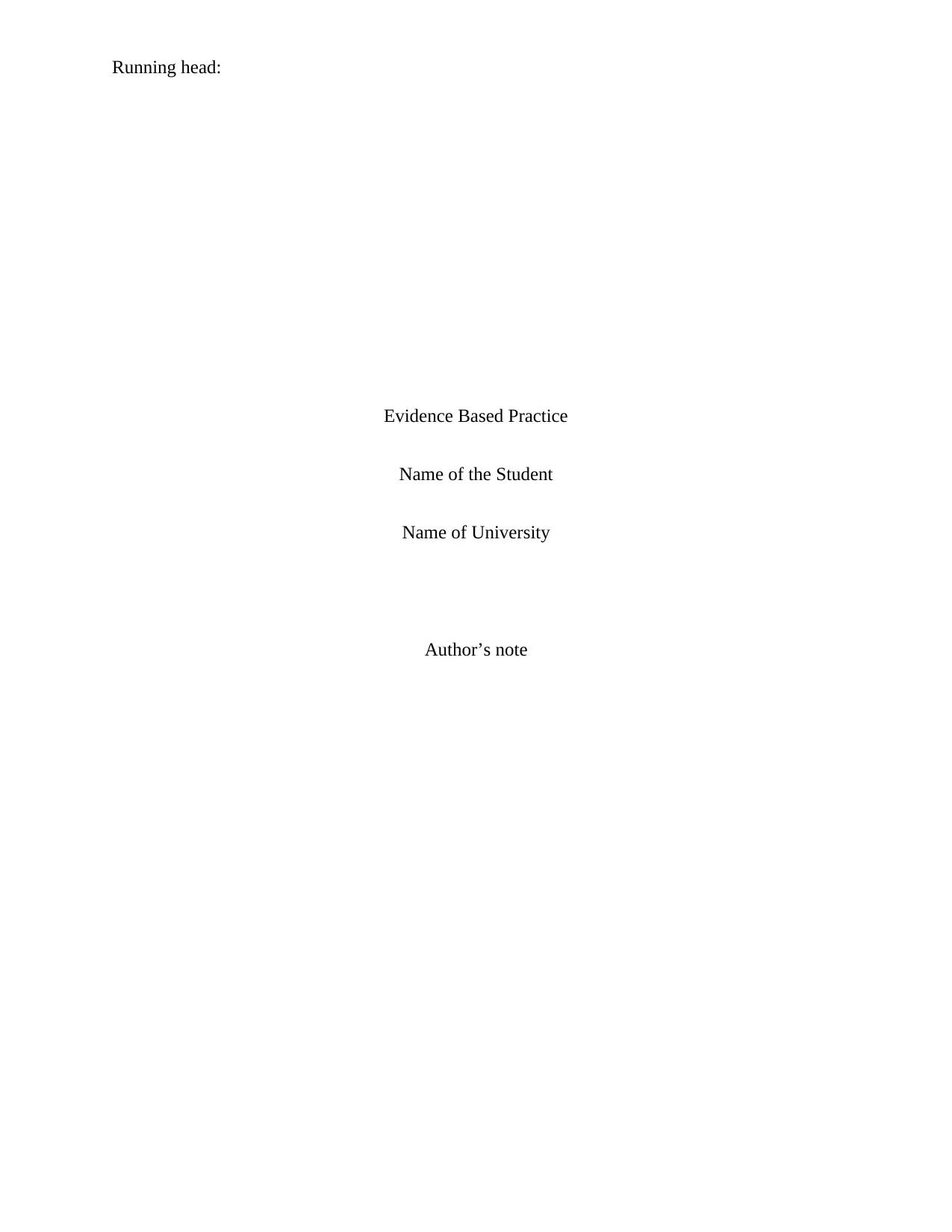
Running head:
Evidence Based Practice
Name of the Student
Name of University
Author’s note
Evidence Based Practice
Name of the Student
Name of University
Author’s note
Paraphrase This Document
Need a fresh take? Get an instant paraphrase of this document with our AI Paraphraser
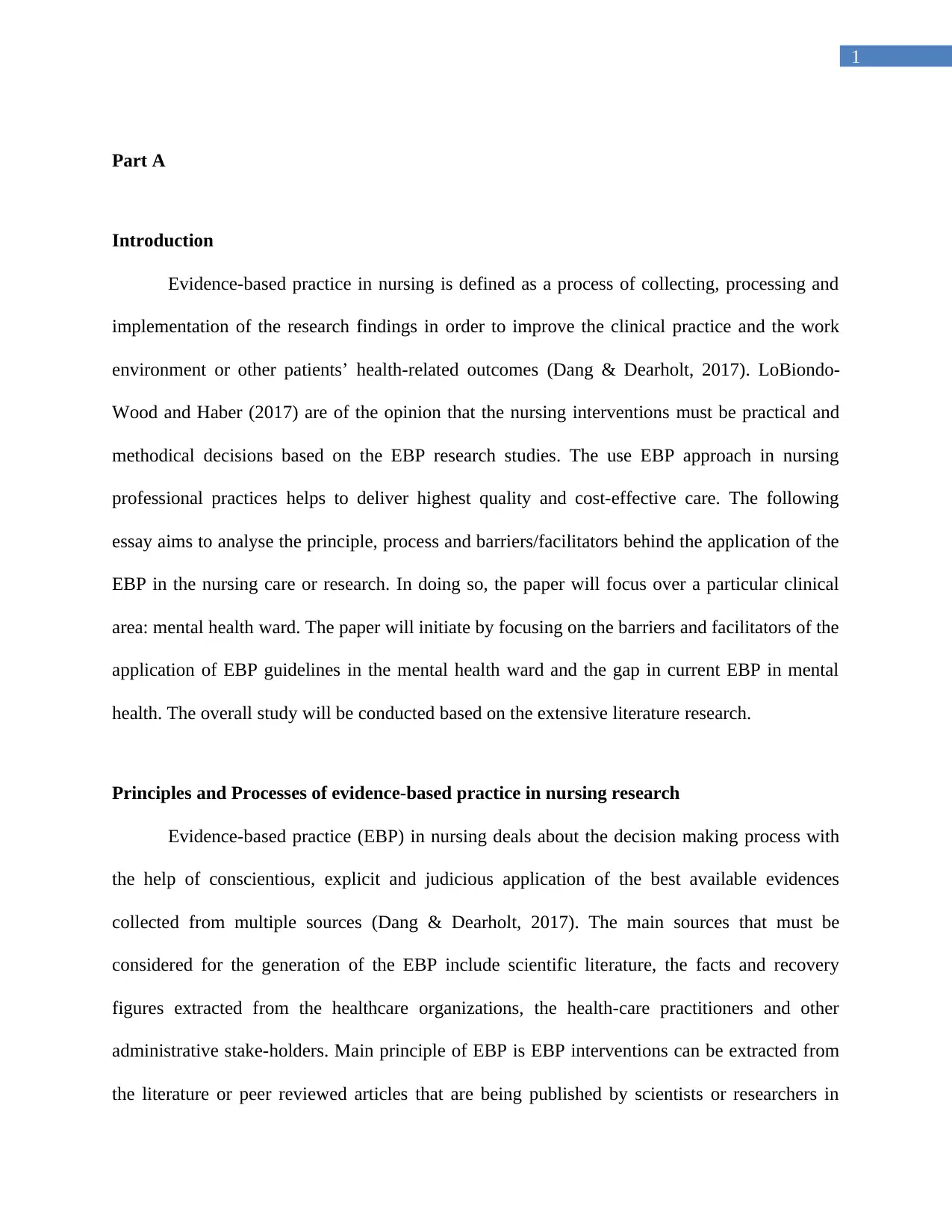
1
Part A
Introduction
Evidence-based practice in nursing is defined as a process of collecting, processing and
implementation of the research findings in order to improve the clinical practice and the work
environment or other patients’ health-related outcomes (Dang & Dearholt, 2017). LoBiondo-
Wood and Haber (2017) are of the opinion that the nursing interventions must be practical and
methodical decisions based on the EBP research studies. The use EBP approach in nursing
professional practices helps to deliver highest quality and cost-effective care. The following
essay aims to analyse the principle, process and barriers/facilitators behind the application of the
EBP in the nursing care or research. In doing so, the paper will focus over a particular clinical
area: mental health ward. The paper will initiate by focusing on the barriers and facilitators of the
application of EBP guidelines in the mental health ward and the gap in current EBP in mental
health. The overall study will be conducted based on the extensive literature research.
Principles and Processes of evidence-based practice in nursing research
Evidence-based practice (EBP) in nursing deals about the decision making process with
the help of conscientious, explicit and judicious application of the best available evidences
collected from multiple sources (Dang & Dearholt, 2017). The main sources that must be
considered for the generation of the EBP include scientific literature, the facts and recovery
figures extracted from the healthcare organizations, the health-care practitioners and other
administrative stake-holders. Main principle of EBP is EBP interventions can be extracted from
the literature or peer reviewed articles that are being published by scientists or researchers in
Part A
Introduction
Evidence-based practice in nursing is defined as a process of collecting, processing and
implementation of the research findings in order to improve the clinical practice and the work
environment or other patients’ health-related outcomes (Dang & Dearholt, 2017). LoBiondo-
Wood and Haber (2017) are of the opinion that the nursing interventions must be practical and
methodical decisions based on the EBP research studies. The use EBP approach in nursing
professional practices helps to deliver highest quality and cost-effective care. The following
essay aims to analyse the principle, process and barriers/facilitators behind the application of the
EBP in the nursing care or research. In doing so, the paper will focus over a particular clinical
area: mental health ward. The paper will initiate by focusing on the barriers and facilitators of the
application of EBP guidelines in the mental health ward and the gap in current EBP in mental
health. The overall study will be conducted based on the extensive literature research.
Principles and Processes of evidence-based practice in nursing research
Evidence-based practice (EBP) in nursing deals about the decision making process with
the help of conscientious, explicit and judicious application of the best available evidences
collected from multiple sources (Dang & Dearholt, 2017). The main sources that must be
considered for the generation of the EBP include scientific literature, the facts and recovery
figures extracted from the healthcare organizations, the health-care practitioners and other
administrative stake-holders. Main principle of EBP is EBP interventions can be extracted from
the literature or peer reviewed articles that are being published by scientists or researchers in
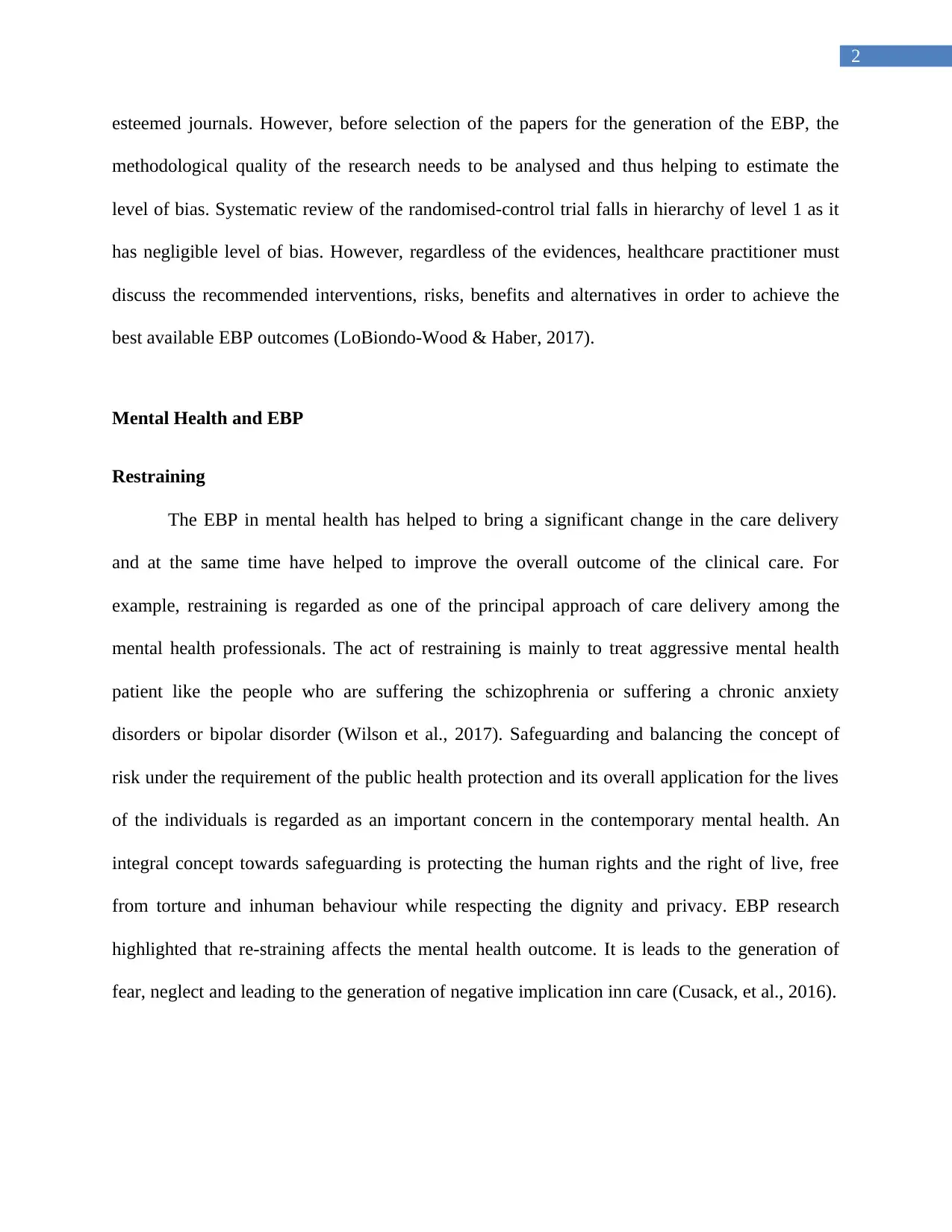
2
esteemed journals. However, before selection of the papers for the generation of the EBP, the
methodological quality of the research needs to be analysed and thus helping to estimate the
level of bias. Systematic review of the randomised-control trial falls in hierarchy of level 1 as it
has negligible level of bias. However, regardless of the evidences, healthcare practitioner must
discuss the recommended interventions, risks, benefits and alternatives in order to achieve the
best available EBP outcomes (LoBiondo-Wood & Haber, 2017).
Mental Health and EBP
Restraining
The EBP in mental health has helped to bring a significant change in the care delivery
and at the same time have helped to improve the overall outcome of the clinical care. For
example, restraining is regarded as one of the principal approach of care delivery among the
mental health professionals. The act of restraining is mainly to treat aggressive mental health
patient like the people who are suffering the schizophrenia or suffering a chronic anxiety
disorders or bipolar disorder (Wilson et al., 2017). Safeguarding and balancing the concept of
risk under the requirement of the public health protection and its overall application for the lives
of the individuals is regarded as an important concern in the contemporary mental health. An
integral concept towards safeguarding is protecting the human rights and the right of live, free
from torture and inhuman behaviour while respecting the dignity and privacy. EBP research
highlighted that re-straining affects the mental health outcome. It is leads to the generation of
fear, neglect and leading to the generation of negative implication inn care (Cusack, et al., 2016).
esteemed journals. However, before selection of the papers for the generation of the EBP, the
methodological quality of the research needs to be analysed and thus helping to estimate the
level of bias. Systematic review of the randomised-control trial falls in hierarchy of level 1 as it
has negligible level of bias. However, regardless of the evidences, healthcare practitioner must
discuss the recommended interventions, risks, benefits and alternatives in order to achieve the
best available EBP outcomes (LoBiondo-Wood & Haber, 2017).
Mental Health and EBP
Restraining
The EBP in mental health has helped to bring a significant change in the care delivery
and at the same time have helped to improve the overall outcome of the clinical care. For
example, restraining is regarded as one of the principal approach of care delivery among the
mental health professionals. The act of restraining is mainly to treat aggressive mental health
patient like the people who are suffering the schizophrenia or suffering a chronic anxiety
disorders or bipolar disorder (Wilson et al., 2017). Safeguarding and balancing the concept of
risk under the requirement of the public health protection and its overall application for the lives
of the individuals is regarded as an important concern in the contemporary mental health. An
integral concept towards safeguarding is protecting the human rights and the right of live, free
from torture and inhuman behaviour while respecting the dignity and privacy. EBP research
highlighted that re-straining affects the mental health outcome. It is leads to the generation of
fear, neglect and leading to the generation of negative implication inn care (Cusack, et al., 2016).
⊘ This is a preview!⊘
Do you want full access?
Subscribe today to unlock all pages.

Trusted by 1+ million students worldwide
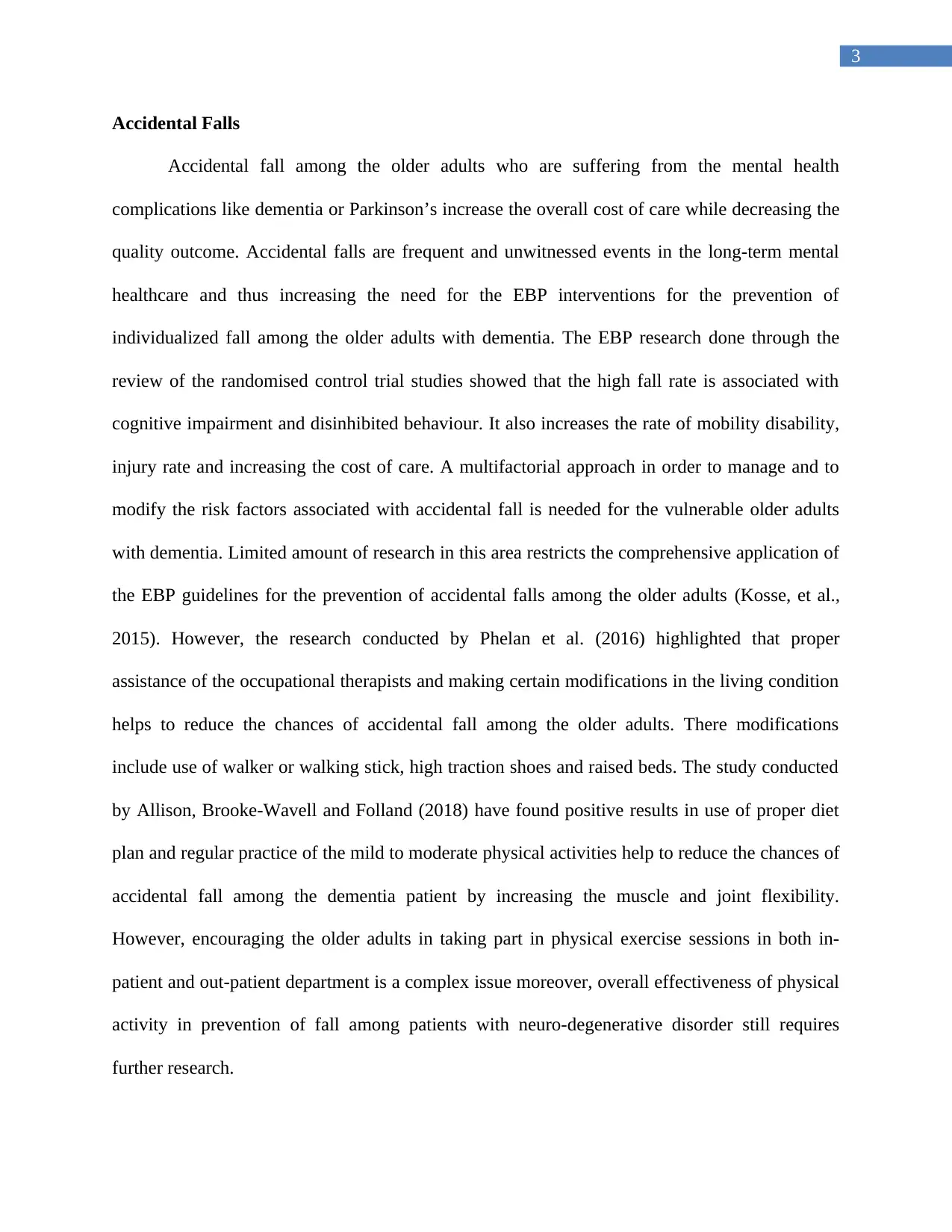
3
Accidental Falls
Accidental fall among the older adults who are suffering from the mental health
complications like dementia or Parkinson’s increase the overall cost of care while decreasing the
quality outcome. Accidental falls are frequent and unwitnessed events in the long-term mental
healthcare and thus increasing the need for the EBP interventions for the prevention of
individualized fall among the older adults with dementia. The EBP research done through the
review of the randomised control trial studies showed that the high fall rate is associated with
cognitive impairment and disinhibited behaviour. It also increases the rate of mobility disability,
injury rate and increasing the cost of care. A multifactorial approach in order to manage and to
modify the risk factors associated with accidental fall is needed for the vulnerable older adults
with dementia. Limited amount of research in this area restricts the comprehensive application of
the EBP guidelines for the prevention of accidental falls among the older adults (Kosse, et al.,
2015). However, the research conducted by Phelan et al. (2016) highlighted that proper
assistance of the occupational therapists and making certain modifications in the living condition
helps to reduce the chances of accidental fall among the older adults. There modifications
include use of walker or walking stick, high traction shoes and raised beds. The study conducted
by Allison, Brooke-Wavell and Folland (2018) have found positive results in use of proper diet
plan and regular practice of the mild to moderate physical activities help to reduce the chances of
accidental fall among the dementia patient by increasing the muscle and joint flexibility.
However, encouraging the older adults in taking part in physical exercise sessions in both in-
patient and out-patient department is a complex issue moreover, overall effectiveness of physical
activity in prevention of fall among patients with neuro-degenerative disorder still requires
further research.
Accidental Falls
Accidental fall among the older adults who are suffering from the mental health
complications like dementia or Parkinson’s increase the overall cost of care while decreasing the
quality outcome. Accidental falls are frequent and unwitnessed events in the long-term mental
healthcare and thus increasing the need for the EBP interventions for the prevention of
individualized fall among the older adults with dementia. The EBP research done through the
review of the randomised control trial studies showed that the high fall rate is associated with
cognitive impairment and disinhibited behaviour. It also increases the rate of mobility disability,
injury rate and increasing the cost of care. A multifactorial approach in order to manage and to
modify the risk factors associated with accidental fall is needed for the vulnerable older adults
with dementia. Limited amount of research in this area restricts the comprehensive application of
the EBP guidelines for the prevention of accidental falls among the older adults (Kosse, et al.,
2015). However, the research conducted by Phelan et al. (2016) highlighted that proper
assistance of the occupational therapists and making certain modifications in the living condition
helps to reduce the chances of accidental fall among the older adults. There modifications
include use of walker or walking stick, high traction shoes and raised beds. The study conducted
by Allison, Brooke-Wavell and Folland (2018) have found positive results in use of proper diet
plan and regular practice of the mild to moderate physical activities help to reduce the chances of
accidental fall among the dementia patient by increasing the muscle and joint flexibility.
However, encouraging the older adults in taking part in physical exercise sessions in both in-
patient and out-patient department is a complex issue moreover, overall effectiveness of physical
activity in prevention of fall among patients with neuro-degenerative disorder still requires
further research.
Paraphrase This Document
Need a fresh take? Get an instant paraphrase of this document with our AI Paraphraser
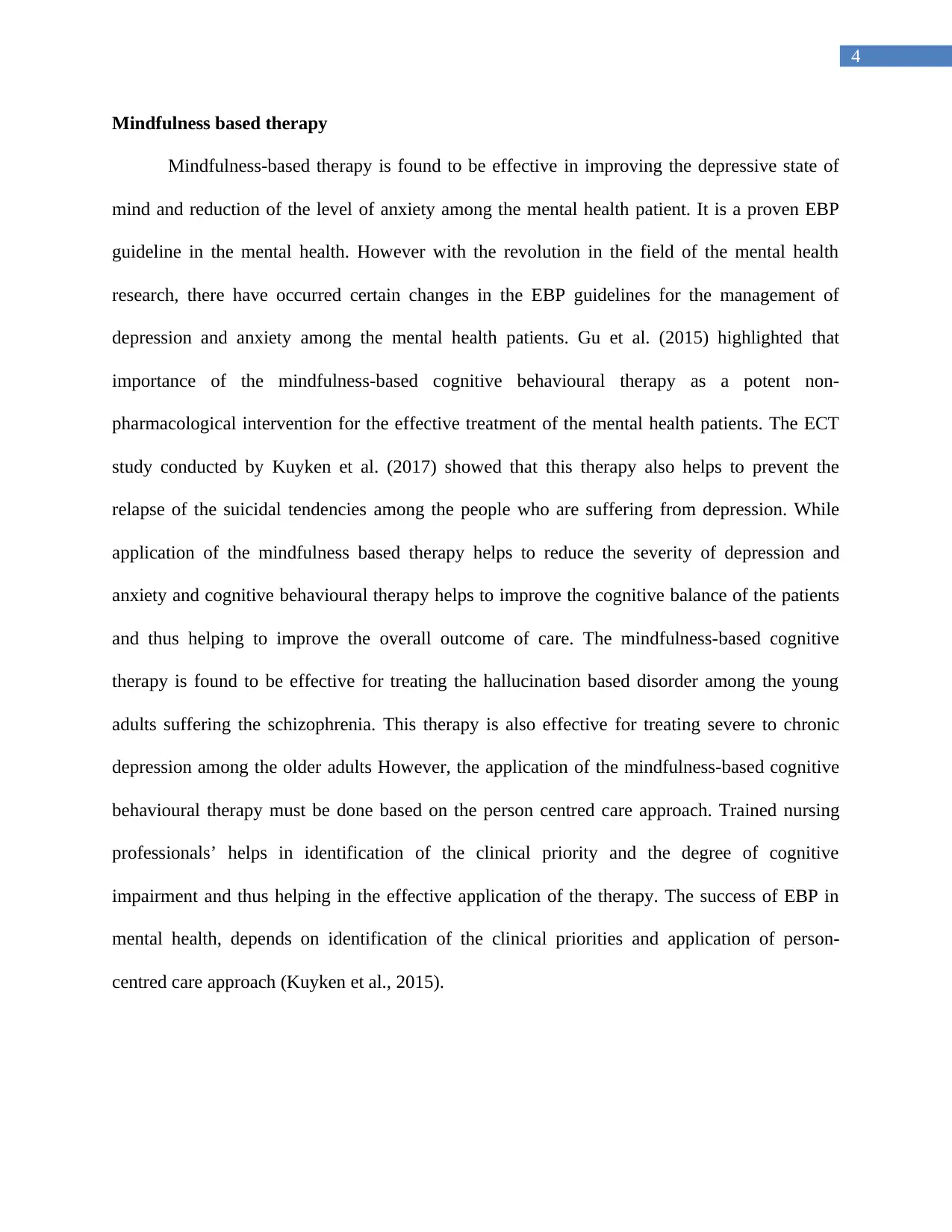
4
Mindfulness based therapy
Mindfulness-based therapy is found to be effective in improving the depressive state of
mind and reduction of the level of anxiety among the mental health patient. It is a proven EBP
guideline in the mental health. However with the revolution in the field of the mental health
research, there have occurred certain changes in the EBP guidelines for the management of
depression and anxiety among the mental health patients. Gu et al. (2015) highlighted that
importance of the mindfulness-based cognitive behavioural therapy as a potent non-
pharmacological intervention for the effective treatment of the mental health patients. The ECT
study conducted by Kuyken et al. (2017) showed that this therapy also helps to prevent the
relapse of the suicidal tendencies among the people who are suffering from depression. While
application of the mindfulness based therapy helps to reduce the severity of depression and
anxiety and cognitive behavioural therapy helps to improve the cognitive balance of the patients
and thus helping to improve the overall outcome of care. The mindfulness-based cognitive
therapy is found to be effective for treating the hallucination based disorder among the young
adults suffering the schizophrenia. This therapy is also effective for treating severe to chronic
depression among the older adults However, the application of the mindfulness-based cognitive
behavioural therapy must be done based on the person centred care approach. Trained nursing
professionals’ helps in identification of the clinical priority and the degree of cognitive
impairment and thus helping in the effective application of the therapy. The success of EBP in
mental health, depends on identification of the clinical priorities and application of person-
centred care approach (Kuyken et al., 2015).
Mindfulness based therapy
Mindfulness-based therapy is found to be effective in improving the depressive state of
mind and reduction of the level of anxiety among the mental health patient. It is a proven EBP
guideline in the mental health. However with the revolution in the field of the mental health
research, there have occurred certain changes in the EBP guidelines for the management of
depression and anxiety among the mental health patients. Gu et al. (2015) highlighted that
importance of the mindfulness-based cognitive behavioural therapy as a potent non-
pharmacological intervention for the effective treatment of the mental health patients. The ECT
study conducted by Kuyken et al. (2017) showed that this therapy also helps to prevent the
relapse of the suicidal tendencies among the people who are suffering from depression. While
application of the mindfulness based therapy helps to reduce the severity of depression and
anxiety and cognitive behavioural therapy helps to improve the cognitive balance of the patients
and thus helping to improve the overall outcome of care. The mindfulness-based cognitive
therapy is found to be effective for treating the hallucination based disorder among the young
adults suffering the schizophrenia. This therapy is also effective for treating severe to chronic
depression among the older adults However, the application of the mindfulness-based cognitive
behavioural therapy must be done based on the person centred care approach. Trained nursing
professionals’ helps in identification of the clinical priority and the degree of cognitive
impairment and thus helping in the effective application of the therapy. The success of EBP in
mental health, depends on identification of the clinical priorities and application of person-
centred care approach (Kuyken et al., 2015).
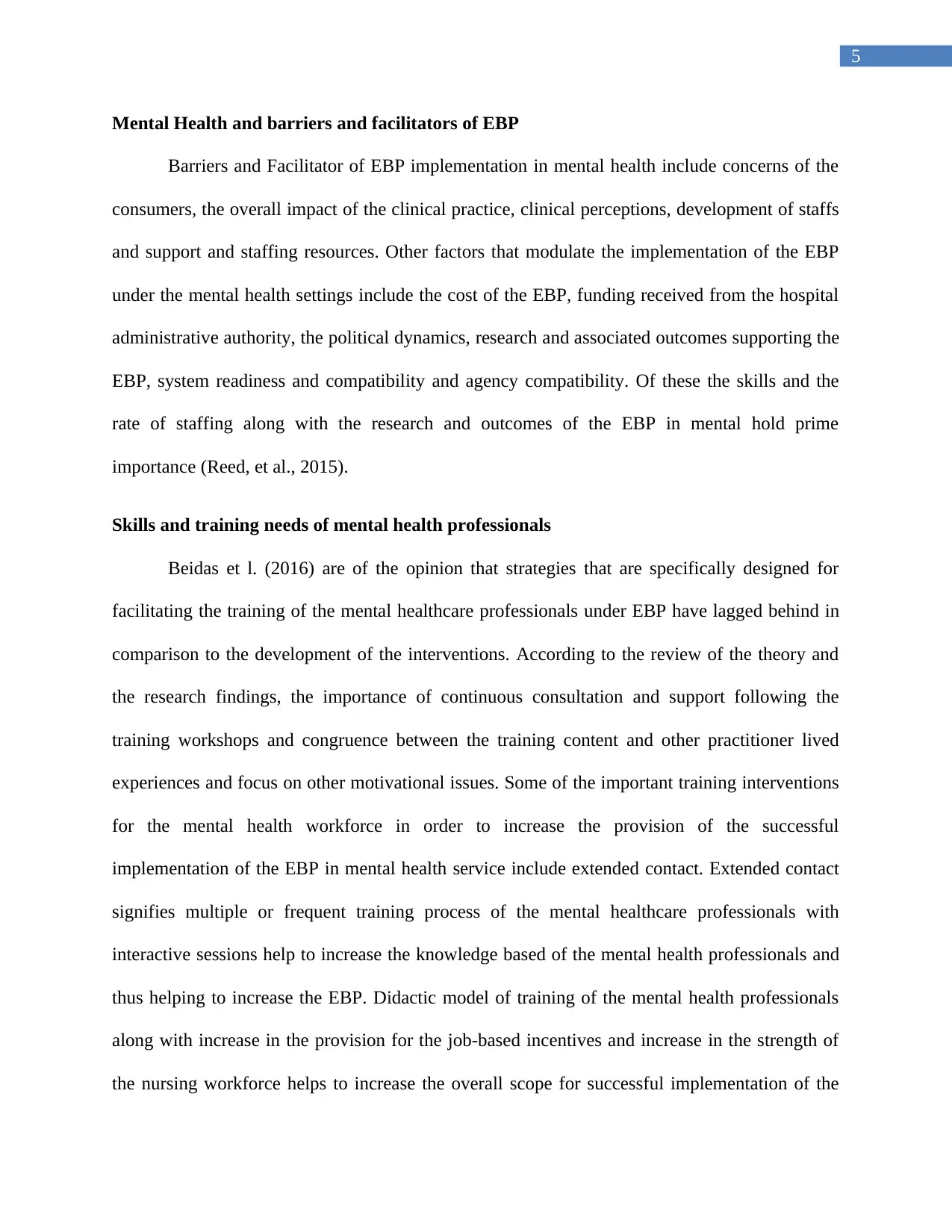
5
Mental Health and barriers and facilitators of EBP
Barriers and Facilitator of EBP implementation in mental health include concerns of the
consumers, the overall impact of the clinical practice, clinical perceptions, development of staffs
and support and staffing resources. Other factors that modulate the implementation of the EBP
under the mental health settings include the cost of the EBP, funding received from the hospital
administrative authority, the political dynamics, research and associated outcomes supporting the
EBP, system readiness and compatibility and agency compatibility. Of these the skills and the
rate of staffing along with the research and outcomes of the EBP in mental hold prime
importance (Reed, et al., 2015).
Skills and training needs of mental health professionals
Beidas et l. (2016) are of the opinion that strategies that are specifically designed for
facilitating the training of the mental healthcare professionals under EBP have lagged behind in
comparison to the development of the interventions. According to the review of the theory and
the research findings, the importance of continuous consultation and support following the
training workshops and congruence between the training content and other practitioner lived
experiences and focus on other motivational issues. Some of the important training interventions
for the mental health workforce in order to increase the provision of the successful
implementation of the EBP in mental health service include extended contact. Extended contact
signifies multiple or frequent training process of the mental healthcare professionals with
interactive sessions help to increase the knowledge based of the mental health professionals and
thus helping to increase the EBP. Didactic model of training of the mental health professionals
along with increase in the provision for the job-based incentives and increase in the strength of
the nursing workforce helps to increase the overall scope for successful implementation of the
Mental Health and barriers and facilitators of EBP
Barriers and Facilitator of EBP implementation in mental health include concerns of the
consumers, the overall impact of the clinical practice, clinical perceptions, development of staffs
and support and staffing resources. Other factors that modulate the implementation of the EBP
under the mental health settings include the cost of the EBP, funding received from the hospital
administrative authority, the political dynamics, research and associated outcomes supporting the
EBP, system readiness and compatibility and agency compatibility. Of these the skills and the
rate of staffing along with the research and outcomes of the EBP in mental hold prime
importance (Reed, et al., 2015).
Skills and training needs of mental health professionals
Beidas et l. (2016) are of the opinion that strategies that are specifically designed for
facilitating the training of the mental healthcare professionals under EBP have lagged behind in
comparison to the development of the interventions. According to the review of the theory and
the research findings, the importance of continuous consultation and support following the
training workshops and congruence between the training content and other practitioner lived
experiences and focus on other motivational issues. Some of the important training interventions
for the mental health workforce in order to increase the provision of the successful
implementation of the EBP in mental health service include extended contact. Extended contact
signifies multiple or frequent training process of the mental healthcare professionals with
interactive sessions help to increase the knowledge based of the mental health professionals and
thus helping to increase the EBP. Didactic model of training of the mental health professionals
along with increase in the provision for the job-based incentives and increase in the strength of
the nursing workforce helps to increase the overall scope for successful implementation of the
⊘ This is a preview!⊘
Do you want full access?
Subscribe today to unlock all pages.

Trusted by 1+ million students worldwide
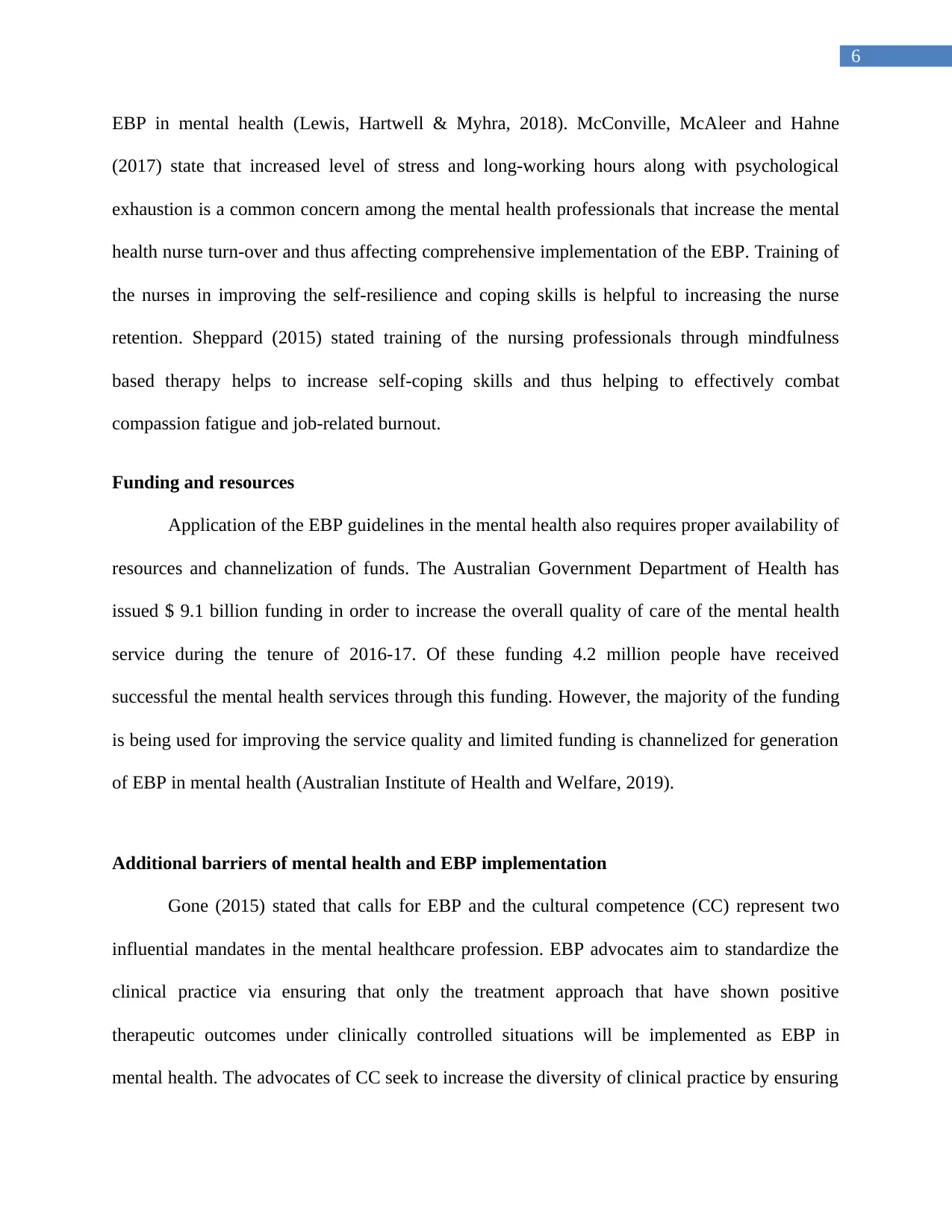
6
EBP in mental health (Lewis, Hartwell & Myhra, 2018). McConville, McAleer and Hahne
(2017) state that increased level of stress and long-working hours along with psychological
exhaustion is a common concern among the mental health professionals that increase the mental
health nurse turn-over and thus affecting comprehensive implementation of the EBP. Training of
the nurses in improving the self-resilience and coping skills is helpful to increasing the nurse
retention. Sheppard (2015) stated training of the nursing professionals through mindfulness
based therapy helps to increase self-coping skills and thus helping to effectively combat
compassion fatigue and job-related burnout.
Funding and resources
Application of the EBP guidelines in the mental health also requires proper availability of
resources and channelization of funds. The Australian Government Department of Health has
issued $ 9.1 billion funding in order to increase the overall quality of care of the mental health
service during the tenure of 2016-17. Of these funding 4.2 million people have received
successful the mental health services through this funding. However, the majority of the funding
is being used for improving the service quality and limited funding is channelized for generation
of EBP in mental health (Australian Institute of Health and Welfare, 2019).
Additional barriers of mental health and EBP implementation
Gone (2015) stated that calls for EBP and the cultural competence (CC) represent two
influential mandates in the mental healthcare profession. EBP advocates aim to standardize the
clinical practice via ensuring that only the treatment approach that have shown positive
therapeutic outcomes under clinically controlled situations will be implemented as EBP in
mental health. The advocates of CC seek to increase the diversity of clinical practice by ensuring
EBP in mental health (Lewis, Hartwell & Myhra, 2018). McConville, McAleer and Hahne
(2017) state that increased level of stress and long-working hours along with psychological
exhaustion is a common concern among the mental health professionals that increase the mental
health nurse turn-over and thus affecting comprehensive implementation of the EBP. Training of
the nurses in improving the self-resilience and coping skills is helpful to increasing the nurse
retention. Sheppard (2015) stated training of the nursing professionals through mindfulness
based therapy helps to increase self-coping skills and thus helping to effectively combat
compassion fatigue and job-related burnout.
Funding and resources
Application of the EBP guidelines in the mental health also requires proper availability of
resources and channelization of funds. The Australian Government Department of Health has
issued $ 9.1 billion funding in order to increase the overall quality of care of the mental health
service during the tenure of 2016-17. Of these funding 4.2 million people have received
successful the mental health services through this funding. However, the majority of the funding
is being used for improving the service quality and limited funding is channelized for generation
of EBP in mental health (Australian Institute of Health and Welfare, 2019).
Additional barriers of mental health and EBP implementation
Gone (2015) stated that calls for EBP and the cultural competence (CC) represent two
influential mandates in the mental healthcare profession. EBP advocates aim to standardize the
clinical practice via ensuring that only the treatment approach that have shown positive
therapeutic outcomes under clinically controlled situations will be implemented as EBP in
mental health. The advocates of CC seek to increase the diversity of clinical practice by ensuring
Paraphrase This Document
Need a fresh take? Get an instant paraphrase of this document with our AI Paraphraser
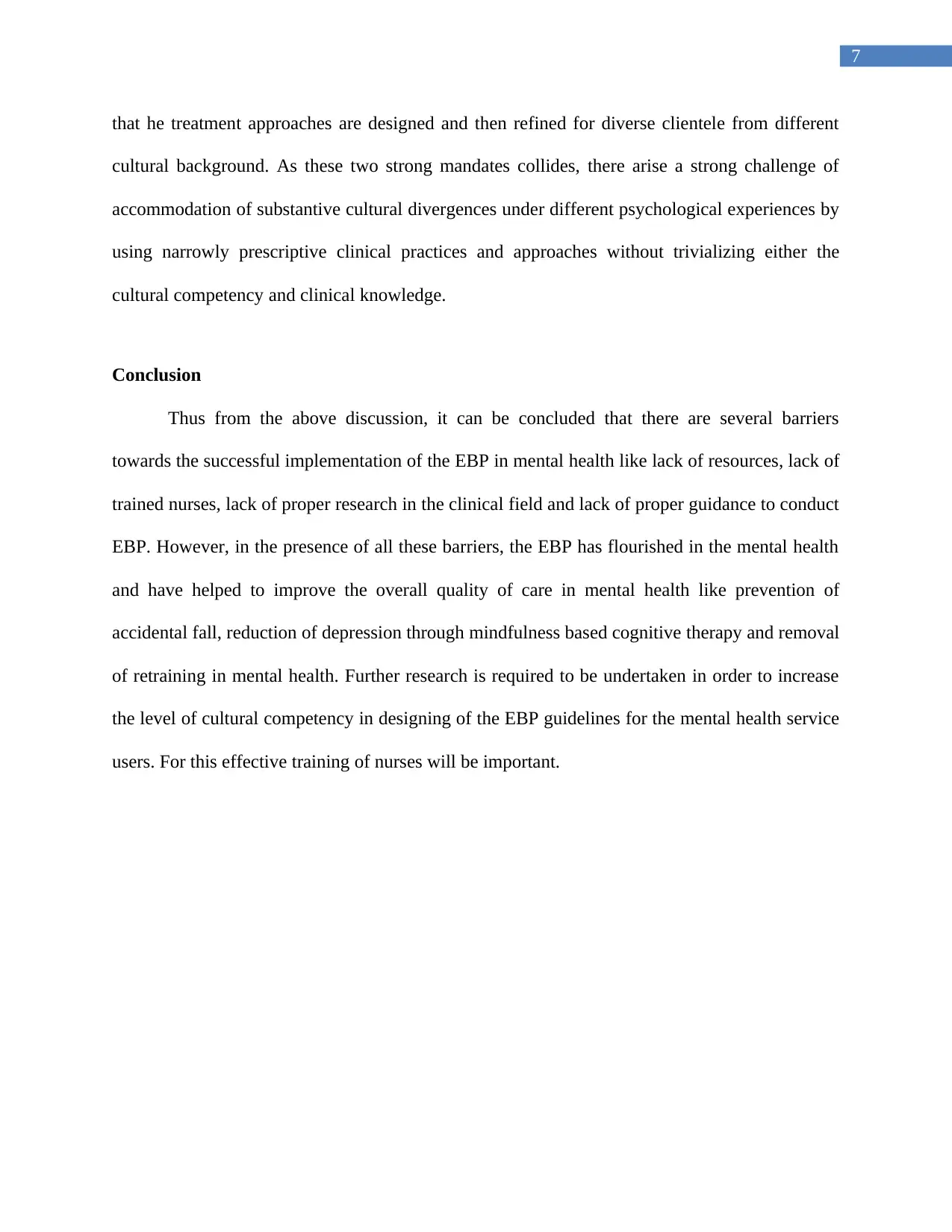
7
that he treatment approaches are designed and then refined for diverse clientele from different
cultural background. As these two strong mandates collides, there arise a strong challenge of
accommodation of substantive cultural divergences under different psychological experiences by
using narrowly prescriptive clinical practices and approaches without trivializing either the
cultural competency and clinical knowledge.
Conclusion
Thus from the above discussion, it can be concluded that there are several barriers
towards the successful implementation of the EBP in mental health like lack of resources, lack of
trained nurses, lack of proper research in the clinical field and lack of proper guidance to conduct
EBP. However, in the presence of all these barriers, the EBP has flourished in the mental health
and have helped to improve the overall quality of care in mental health like prevention of
accidental fall, reduction of depression through mindfulness based cognitive therapy and removal
of retraining in mental health. Further research is required to be undertaken in order to increase
the level of cultural competency in designing of the EBP guidelines for the mental health service
users. For this effective training of nurses will be important.
that he treatment approaches are designed and then refined for diverse clientele from different
cultural background. As these two strong mandates collides, there arise a strong challenge of
accommodation of substantive cultural divergences under different psychological experiences by
using narrowly prescriptive clinical practices and approaches without trivializing either the
cultural competency and clinical knowledge.
Conclusion
Thus from the above discussion, it can be concluded that there are several barriers
towards the successful implementation of the EBP in mental health like lack of resources, lack of
trained nurses, lack of proper research in the clinical field and lack of proper guidance to conduct
EBP. However, in the presence of all these barriers, the EBP has flourished in the mental health
and have helped to improve the overall quality of care in mental health like prevention of
accidental fall, reduction of depression through mindfulness based cognitive therapy and removal
of retraining in mental health. Further research is required to be undertaken in order to increase
the level of cultural competency in designing of the EBP guidelines for the mental health service
users. For this effective training of nurses will be important.
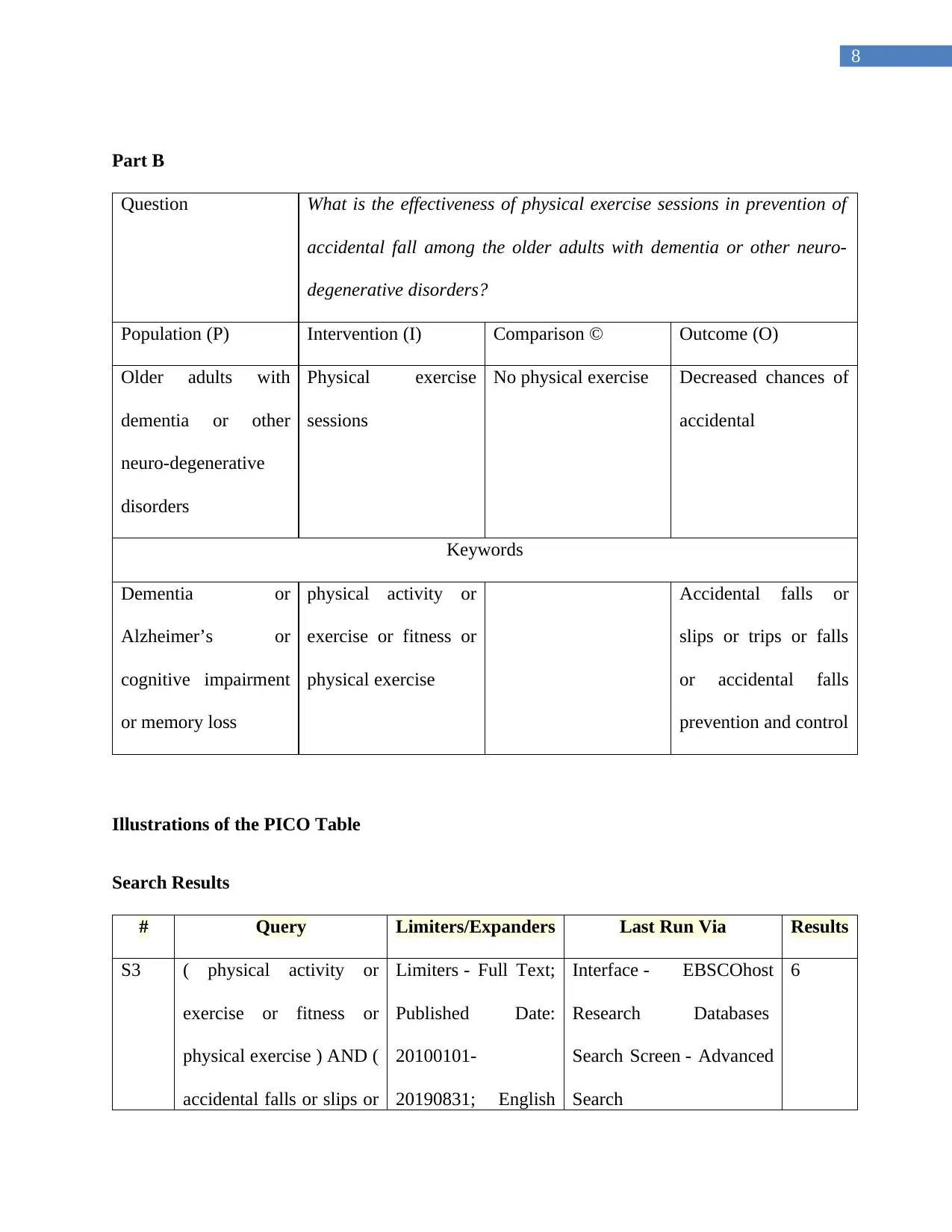
8
Part B
Question What is the effectiveness of physical exercise sessions in prevention of
accidental fall among the older adults with dementia or other neuro-
degenerative disorders?
Population (P) Intervention (I) Comparison © Outcome (O)
Older adults with
dementia or other
neuro-degenerative
disorders
Physical exercise
sessions
No physical exercise Decreased chances of
accidental
Keywords
Dementia or
Alzheimer’s or
cognitive impairment
or memory loss
physical activity or
exercise or fitness or
physical exercise
Accidental falls or
slips or trips or falls
or accidental falls
prevention and control
Illustrations of the PICO Table
Search Results
# Query Limiters/Expanders Last Run Via Results
S3 ( physical activity or
exercise or fitness or
physical exercise ) AND (
accidental falls or slips or
Limiters - Full Text;
Published Date:
20100101-
20190831; English
Interface - EBSCOhost
Research Databases
Search Screen - Advanced
Search
6
Part B
Question What is the effectiveness of physical exercise sessions in prevention of
accidental fall among the older adults with dementia or other neuro-
degenerative disorders?
Population (P) Intervention (I) Comparison © Outcome (O)
Older adults with
dementia or other
neuro-degenerative
disorders
Physical exercise
sessions
No physical exercise Decreased chances of
accidental
Keywords
Dementia or
Alzheimer’s or
cognitive impairment
or memory loss
physical activity or
exercise or fitness or
physical exercise
Accidental falls or
slips or trips or falls
or accidental falls
prevention and control
Illustrations of the PICO Table
Search Results
# Query Limiters/Expanders Last Run Via Results
S3 ( physical activity or
exercise or fitness or
physical exercise ) AND (
accidental falls or slips or
Limiters - Full Text;
Published Date:
20100101-
20190831; English
Interface - EBSCOhost
Research Databases
Search Screen - Advanced
Search
6
⊘ This is a preview!⊘
Do you want full access?
Subscribe today to unlock all pages.

Trusted by 1+ million students worldwide
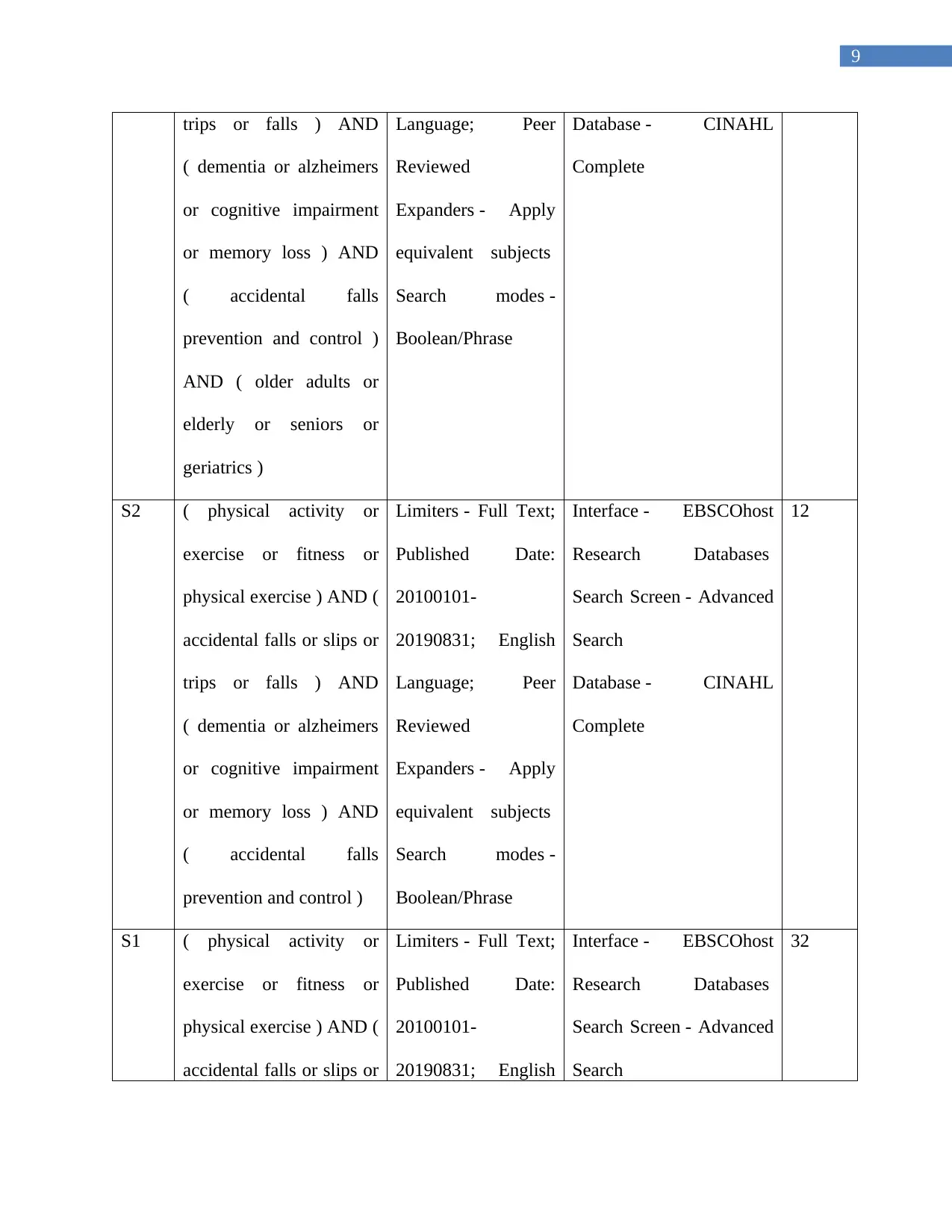
9
trips or falls ) AND
( dementia or alzheimers
or cognitive impairment
or memory loss ) AND
( accidental falls
prevention and control )
AND ( older adults or
elderly or seniors or
geriatrics )
Language; Peer
Reviewed
Expanders - Apply
equivalent subjects
Search modes -
Boolean/Phrase
Database - CINAHL
Complete
S2 ( physical activity or
exercise or fitness or
physical exercise ) AND (
accidental falls or slips or
trips or falls ) AND
( dementia or alzheimers
or cognitive impairment
or memory loss ) AND
( accidental falls
prevention and control )
Limiters - Full Text;
Published Date:
20100101-
20190831; English
Language; Peer
Reviewed
Expanders - Apply
equivalent subjects
Search modes -
Boolean/Phrase
Interface - EBSCOhost
Research Databases
Search Screen - Advanced
Search
Database - CINAHL
Complete
12
S1 ( physical activity or
exercise or fitness or
physical exercise ) AND (
accidental falls or slips or
Limiters - Full Text;
Published Date:
20100101-
20190831; English
Interface - EBSCOhost
Research Databases
Search Screen - Advanced
Search
32
trips or falls ) AND
( dementia or alzheimers
or cognitive impairment
or memory loss ) AND
( accidental falls
prevention and control )
AND ( older adults or
elderly or seniors or
geriatrics )
Language; Peer
Reviewed
Expanders - Apply
equivalent subjects
Search modes -
Boolean/Phrase
Database - CINAHL
Complete
S2 ( physical activity or
exercise or fitness or
physical exercise ) AND (
accidental falls or slips or
trips or falls ) AND
( dementia or alzheimers
or cognitive impairment
or memory loss ) AND
( accidental falls
prevention and control )
Limiters - Full Text;
Published Date:
20100101-
20190831; English
Language; Peer
Reviewed
Expanders - Apply
equivalent subjects
Search modes -
Boolean/Phrase
Interface - EBSCOhost
Research Databases
Search Screen - Advanced
Search
Database - CINAHL
Complete
12
S1 ( physical activity or
exercise or fitness or
physical exercise ) AND (
accidental falls or slips or
Limiters - Full Text;
Published Date:
20100101-
20190831; English
Interface - EBSCOhost
Research Databases
Search Screen - Advanced
Search
32
Paraphrase This Document
Need a fresh take? Get an instant paraphrase of this document with our AI Paraphraser
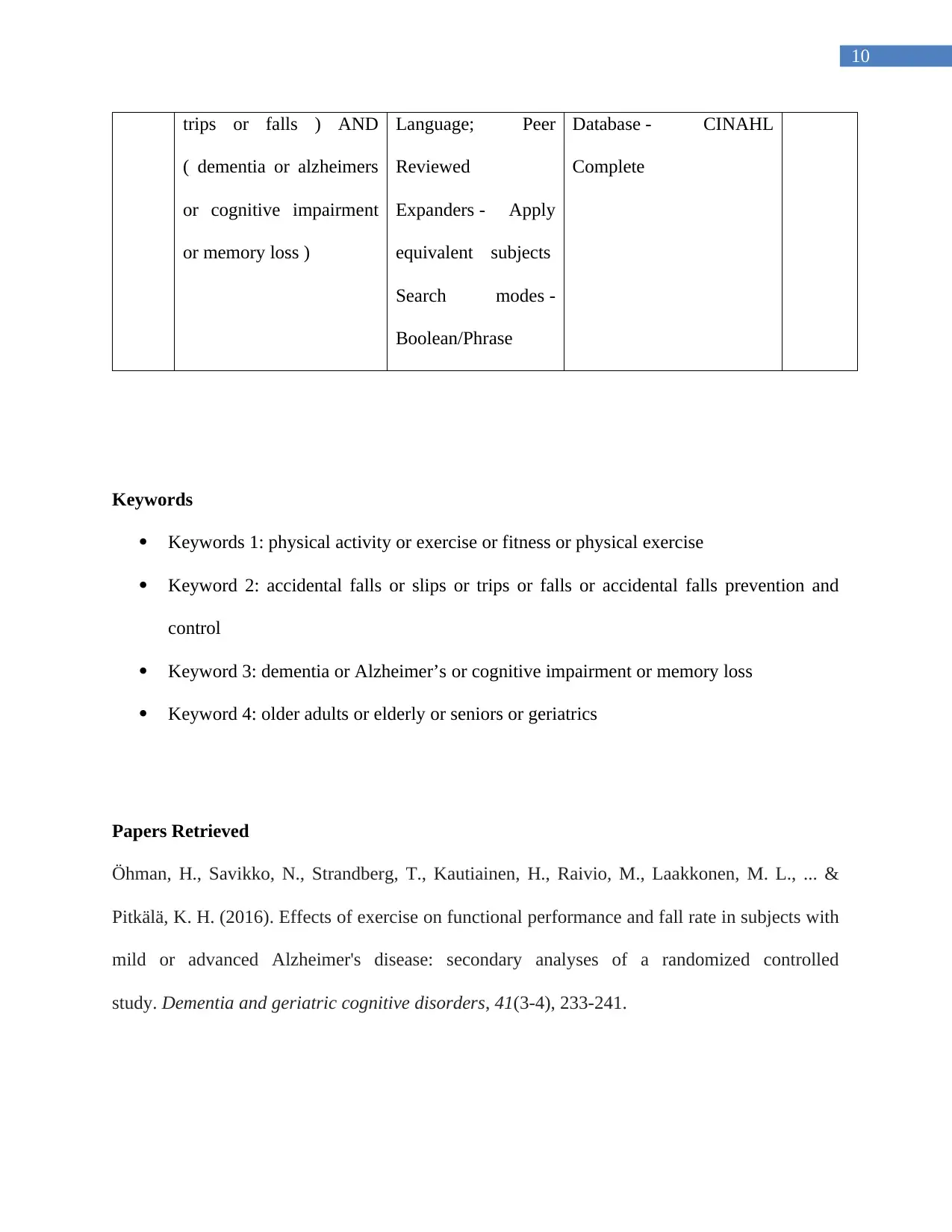
10
trips or falls ) AND
( dementia or alzheimers
or cognitive impairment
or memory loss )
Language; Peer
Reviewed
Expanders - Apply
equivalent subjects
Search modes -
Boolean/Phrase
Database - CINAHL
Complete
Keywords
Keywords 1: physical activity or exercise or fitness or physical exercise
Keyword 2: accidental falls or slips or trips or falls or accidental falls prevention and
control
Keyword 3: dementia or Alzheimer’s or cognitive impairment or memory loss
Keyword 4: older adults or elderly or seniors or geriatrics
Papers Retrieved
Öhman, H., Savikko, N., Strandberg, T., Kautiainen, H., Raivio, M., Laakkonen, M. L., ... &
Pitkälä, K. H. (2016). Effects of exercise on functional performance and fall rate in subjects with
mild or advanced Alzheimer's disease: secondary analyses of a randomized controlled
study. Dementia and geriatric cognitive disorders, 41(3-4), 233-241.
trips or falls ) AND
( dementia or alzheimers
or cognitive impairment
or memory loss )
Language; Peer
Reviewed
Expanders - Apply
equivalent subjects
Search modes -
Boolean/Phrase
Database - CINAHL
Complete
Keywords
Keywords 1: physical activity or exercise or fitness or physical exercise
Keyword 2: accidental falls or slips or trips or falls or accidental falls prevention and
control
Keyword 3: dementia or Alzheimer’s or cognitive impairment or memory loss
Keyword 4: older adults or elderly or seniors or geriatrics
Papers Retrieved
Öhman, H., Savikko, N., Strandberg, T., Kautiainen, H., Raivio, M., Laakkonen, M. L., ... &
Pitkälä, K. H. (2016). Effects of exercise on functional performance and fall rate in subjects with
mild or advanced Alzheimer's disease: secondary analyses of a randomized controlled
study. Dementia and geriatric cognitive disorders, 41(3-4), 233-241.
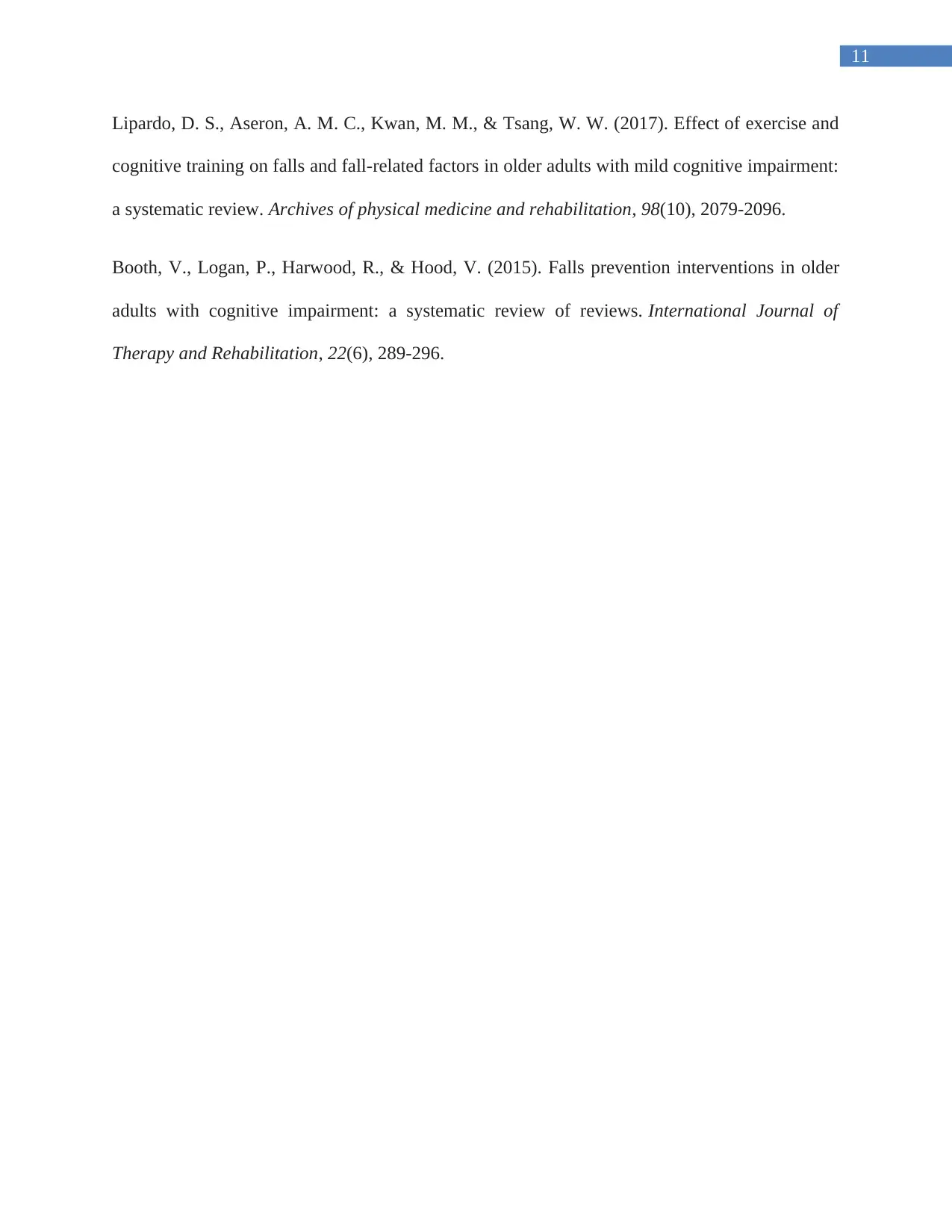
11
Lipardo, D. S., Aseron, A. M. C., Kwan, M. M., & Tsang, W. W. (2017). Effect of exercise and
cognitive training on falls and fall-related factors in older adults with mild cognitive impairment:
a systematic review. Archives of physical medicine and rehabilitation, 98(10), 2079-2096.
Booth, V., Logan, P., Harwood, R., & Hood, V. (2015). Falls prevention interventions in older
adults with cognitive impairment: a systematic review of reviews. International Journal of
Therapy and Rehabilitation, 22(6), 289-296.
Lipardo, D. S., Aseron, A. M. C., Kwan, M. M., & Tsang, W. W. (2017). Effect of exercise and
cognitive training on falls and fall-related factors in older adults with mild cognitive impairment:
a systematic review. Archives of physical medicine and rehabilitation, 98(10), 2079-2096.
Booth, V., Logan, P., Harwood, R., & Hood, V. (2015). Falls prevention interventions in older
adults with cognitive impairment: a systematic review of reviews. International Journal of
Therapy and Rehabilitation, 22(6), 289-296.
⊘ This is a preview!⊘
Do you want full access?
Subscribe today to unlock all pages.

Trusted by 1+ million students worldwide
1 out of 16
Related Documents
Your All-in-One AI-Powered Toolkit for Academic Success.
+13062052269
info@desklib.com
Available 24*7 on WhatsApp / Email
![[object Object]](/_next/static/media/star-bottom.7253800d.svg)
Unlock your academic potential
Copyright © 2020–2025 A2Z Services. All Rights Reserved. Developed and managed by ZUCOL.





